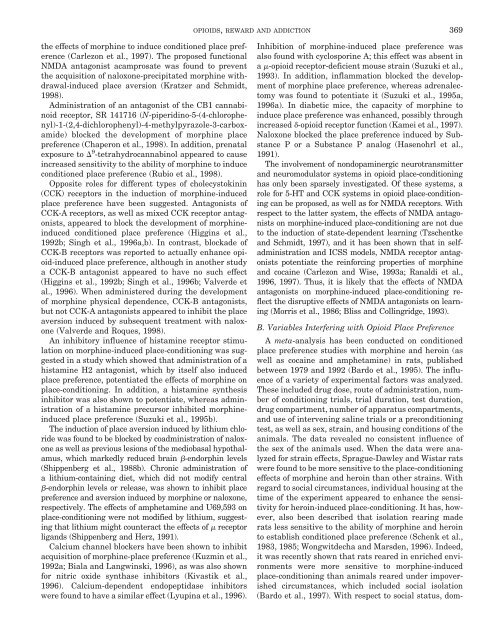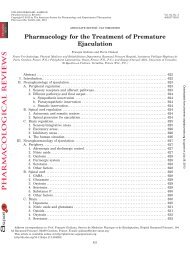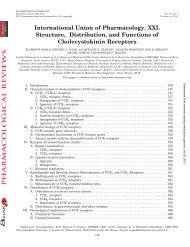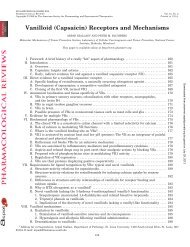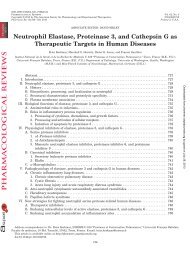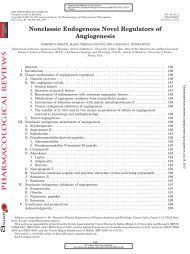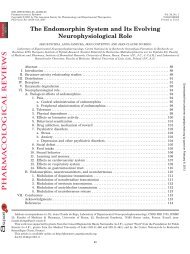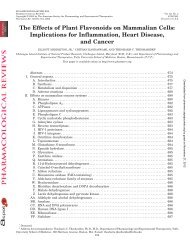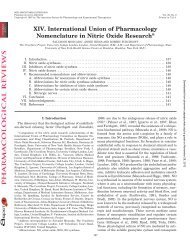Opioids, Reward and Addiction: An Encounter of Biology ...
Opioids, Reward and Addiction: An Encounter of Biology ...
Opioids, Reward and Addiction: An Encounter of Biology ...
Create successful ePaper yourself
Turn your PDF publications into a flip-book with our unique Google optimized e-Paper software.
the effects <strong>of</strong> morphine to induce conditioned place preference<br />
(Carlezon et al., 1997). The proposed functional<br />
NMDA antagonist acamprosate was found to prevent<br />
the acquisition <strong>of</strong> naloxone-precipitated morphine withdrawal-induced<br />
place aversion (Kratzer <strong>and</strong> Schmidt,<br />
1998).<br />
Administration <strong>of</strong> an antagonist <strong>of</strong> the CB1 cannabinoid<br />
receptor, SR 141716 (N-piperidino-5-(4-chlorophenyl)-1-(2,4-dichlorophenyl)-4-methylpyrazole-3-carboxamide)<br />
blocked the development <strong>of</strong> morphine place<br />
preference (Chaperon et al., 1998). In addition, prenatal<br />
exposure to 9 -tetrahydrocannabinol appeared to cause<br />
increased sensitivity to the ability <strong>of</strong> morphine to induce<br />
conditioned place preference (Rubio et al., 1998).<br />
Opposite roles for different types <strong>of</strong> cholecystokinin<br />
(CCK) receptors in the induction <strong>of</strong> morphine-induced<br />
place preference have been suggested. <strong>An</strong>tagonists <strong>of</strong><br />
CCK-A receptors, as well as mixed CCK receptor antagonists,<br />
appeared to block the development <strong>of</strong> morphineinduced<br />
conditioned place preference (Higgins et al.,<br />
1992b; Singh et al., 1996a,b). In contrast, blockade <strong>of</strong><br />
CCK-B receptors was reported to actually enhance opioid-induced<br />
place preference, although in another study<br />
a CCK-B antagonist appeared to have no such effect<br />
(Higgins et al., 1992b; Singh et al., 1996b; Valverde et<br />
al., 1996). When administered during the development<br />
<strong>of</strong> morphine physical dependence, CCK-B antagonists,<br />
but not CCK-A antagonists appeared to inhibit the place<br />
aversion induced by subsequent treatment with naloxone<br />
(Valverde <strong>and</strong> Roques, 1998).<br />
<strong>An</strong> inhibitory influence <strong>of</strong> histamine receptor stimulation<br />
on morphine-induced place-conditioning was suggested<br />
in a study which showed that administration <strong>of</strong> a<br />
histamine H2 antagonist, which by itself also induced<br />
place preference, potentiated the effects <strong>of</strong> morphine on<br />
place-conditioning. In addition, a histamine synthesis<br />
inhibitor was also shown to potentiate, whereas administration<br />
<strong>of</strong> a histamine precursor inhibited morphineinduced<br />
place preference (Suzuki et al., 1995b).<br />
The induction <strong>of</strong> place aversion induced by lithium chloride<br />
was found to be blocked by coadministration <strong>of</strong> naloxone<br />
as well as previous lesions <strong>of</strong> the mediobasal hypothalamus,<br />
which markedly reduced brain -endorphin levels<br />
(Shippenberg et al., 1988b). Chronic administration <strong>of</strong><br />
a lithium-containing diet, which did not modify central<br />
-endorphin levels or release, was shown to inhibit place<br />
preference <strong>and</strong> aversion induced by morphine or naloxone,<br />
respectively. The effects <strong>of</strong> amphetamine <strong>and</strong> U69,593 on<br />
place-conditioning were not modified by lithium, suggesting<br />
that lithium might counteract the effects <strong>of</strong> receptor<br />
lig<strong>and</strong>s (Shippenberg <strong>and</strong> Herz, 1991).<br />
Calcium channel blockers have been shown to inhibit<br />
acquisition <strong>of</strong> morphine-place preference (Kuzmin et al.,<br />
1992a; Biala <strong>and</strong> Langwinski, 1996), as was also shown<br />
for nitric oxide synthase inhibitors (Kivastik et al.,<br />
1996). Calcium-dependent endopeptidase inhibitors<br />
were found to have a similar effect (Lyupina et al., 1996).<br />
OPIOIDS, REWARD AND ADDICTION 369<br />
Inhibition <strong>of</strong> morphine-induced place preference was<br />
also found with cyclosporine A; this effect was absent in<br />
a -opioid receptor-deficient mouse strain (Suzuki et al.,<br />
1993). In addition, inflammation blocked the development<br />
<strong>of</strong> morphine place preference, whereas adrenalectomy<br />
was found to potentiate it (Suzuki et al., 1995a,<br />
1996a). In diabetic mice, the capacity <strong>of</strong> morphine to<br />
induce place preference was enhanced, possibly through<br />
increased -opioid receptor function (Kamei et al., 1997).<br />
Naloxone blocked the place preference induced by Substance<br />
P or a Substance P analog (Hasenohrl et al.,<br />
1991).<br />
The involvement <strong>of</strong> nondopaminergic neurotransmitter<br />
<strong>and</strong> neuromodulator systems in opioid place-conditioning<br />
has only been sparsely investigated. Of these systems, a<br />
role for 5-HT <strong>and</strong> CCK systems in opioid place-conditioning<br />
can be proposed, as well as for NMDA receptors. With<br />
respect to the latter system, the effects <strong>of</strong> NMDA antagonists<br />
on morphine-induced place-conditioning are not due<br />
to the induction <strong>of</strong> state-dependent learning (Tzschentke<br />
<strong>and</strong> Schmidt, 1997), <strong>and</strong> it has been shown that in selfadministration<br />
<strong>and</strong> ICSS models, NMDA receptor antagonists<br />
potentiate the reinforcing properties <strong>of</strong> morphine<br />
<strong>and</strong> cocaine (Carlezon <strong>and</strong> Wise, 1993a; Ranaldi et al.,<br />
1996, 1997). Thus, it is likely that the effects <strong>of</strong> NMDA<br />
antagonists on morphine-induced place-conditioning reflect<br />
the disruptive effects <strong>of</strong> NMDA antagonists on learning<br />
(Morris et al., 1986; Bliss <strong>and</strong> Collingridge, 1993).<br />
B. Variables Interfering with Opioid Place Preference<br />
A meta-analysis has been conducted on conditioned<br />
place preference studies with morphine <strong>and</strong> heroin (as<br />
well as cocaine <strong>and</strong> amphetamine) in rats, published<br />
between 1979 <strong>and</strong> 1992 (Bardo et al., 1995). The influence<br />
<strong>of</strong> a variety <strong>of</strong> experimental factors was analyzed.<br />
These included drug dose, route <strong>of</strong> administration, number<br />
<strong>of</strong> conditioning trials, trial duration, test duration,<br />
drug compartment, number <strong>of</strong> apparatus compartments,<br />
<strong>and</strong> use <strong>of</strong> intervening saline trials or a preconditioning<br />
test, as well as sex, strain, <strong>and</strong> housing conditions <strong>of</strong> the<br />
animals. The data revealed no consistent influence <strong>of</strong><br />
the sex <strong>of</strong> the animals used. When the data were analyzed<br />
for strain effects, Sprague-Dawley <strong>and</strong> Wistar rats<br />
were found to be more sensitive to the place-conditioning<br />
effects <strong>of</strong> morphine <strong>and</strong> heroin than other strains. With<br />
regard to social circumstances, individual housing at the<br />
time <strong>of</strong> the experiment appeared to enhance the sensitivity<br />
for heroin-induced place-conditioning. It has, however,<br />
also been described that isolation rearing made<br />
rats less sensitive to the ability <strong>of</strong> morphine <strong>and</strong> heroin<br />
to establish conditioned place preference (Schenk et al.,<br />
1983, 1985; Wongwitdecha <strong>and</strong> Marsden, 1996). Indeed,<br />
it was recently shown that rats reared in enriched environments<br />
were more sensitive to morphine-induced<br />
place-conditioning than animals reared under impoverished<br />
circumstances, which included social isolation<br />
(Bardo et al., 1997). With respect to social status, dom-


